Definition and features of wood stain
Many builders call staining compounds stains, these are the same stains, it’s just that the name “stain” is older. Stains, unlike paint, do not hide the wood grain while adding color, but on the contrary, make it more pronounced and bright.
In essence, stains are impregnations that penetrate the structure and change the shade from the inside. Modern stains protect wood from the harmful effects of moisture, mold and other harmful factors. It is recommended to fix the result of the work with a finishing coat of varnish, wax or special oil for wood.
Modern stains are sold in almost every hardware store in dry and liquid form. If you want to get a certain shade, then you should buy a stain concentrate and then dilute it to the desired shade.
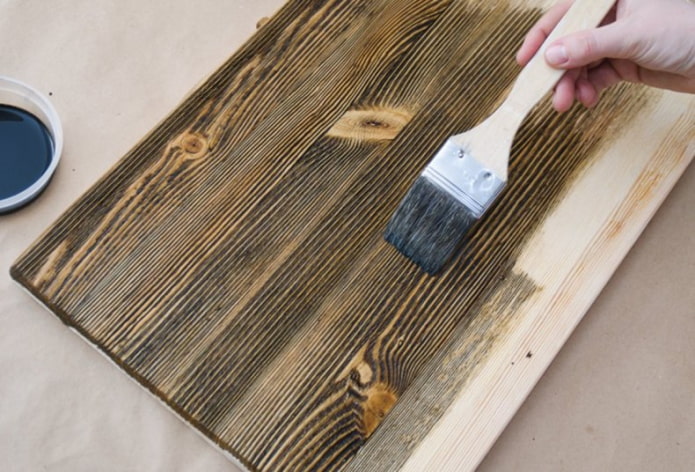
What is it used for?
Stain can be used for interior and exterior wood coatings. They usually treat furniture, wooden frames, accessories and much more.
The main purpose of stain is to protect wood from external factors (fading, insects, precipitation, etc.), as well as decorative treatment and tarnishing to even out the color.
Types of compositions
Manufacturers offer several types of stains for different purposes to suit every taste and budget.
Water-based compositions
They belong to the budget segment and are the most popular for use at home. They are available in the form of a liquid or powder, which must first be diluted and then filtered so that undissolved grains do not leave stains on the wooden surface.
Water-based compositions are ideal for interior work, they are easy to apply, non-toxic, without a pronounced odor, and there is no need to use respirators or other PPE when applying.
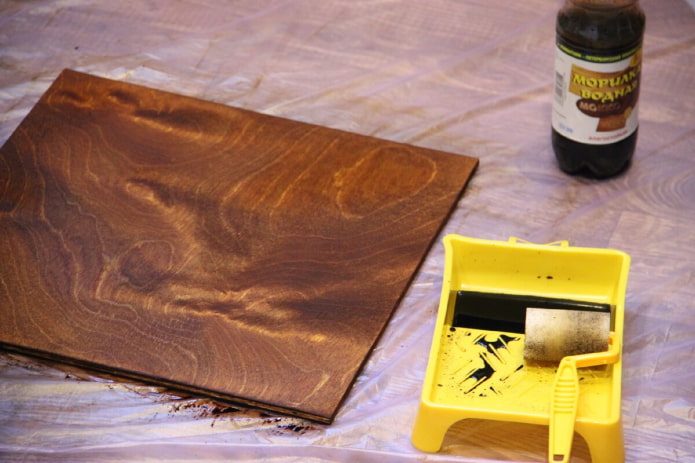
Water-based paints penetrate deeply into the wood, emphasizing its structure and natural pattern. When working, it is easy to adjust the brightness of the coloring, if the stain is darker than necessary, just add water, the color will become lighter, to obtain a darker shade, several layers are applied in stages, before applying the next layer, the previous one must be completely dry, the minimum drying time for water-based compositions is 12 hours.
To prevent stains from appearing on the product, it is advisable to sand the wooden surface before staining. Water-based stain, penetrating the wood, raises its fibers, so after drying, sanding is also required. After drying, the surface must be covered with varnish or another finishing coating to close the pores of the wood and extend its service life.
Oil stains
They are a mixture of organic or synthetic oils and dye. Oil, penetrating the pores, cares for the wood, makes it moisture-resistant, extends its service life and improves the structure. Oil stains create a denser layer, do not flow and dry faster than water-based ones, on average, it takes from 6 to 12 hours to dry.
Due to the denser coating, the color turns out brighter and more saturated compared to water-based impregnations, in addition, the oil will protect the wood from moisture and sunlight. Oil stains are suitable for both indoor and outdoor use, they are often used to tint parquet floors, the coating not only colors, but also protects the surface from scratches and premature wear.
With long-term storage, oil stains can thicken, become viscous and inconvenient to work with, then the composition must be thoroughly mixed, adding white spirit solvent while stirring.
For the final coating of the product, it is recommended to use a special oil for wood, varnish applied over the oil will not be absorbed into closed pores, and after drying will crack and spoil the appearance of the coating.
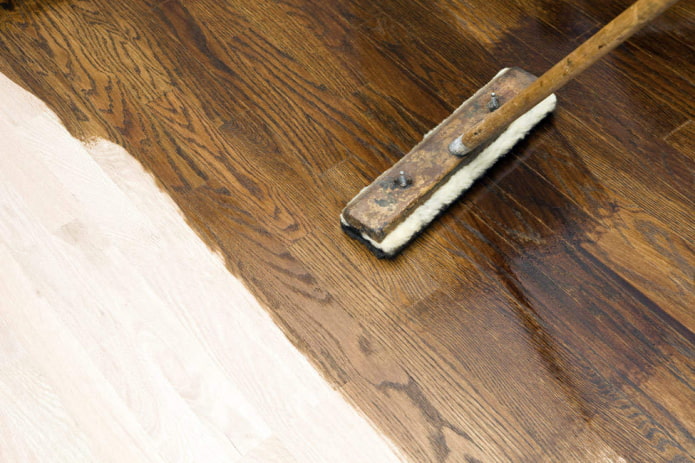
Alcohol stains
Contain denatured alcohols and aniline dyes, sold both in ready-made liquid form and in powder form. Due to the high volatility of alcohols, pigments do not have time to penetrate deeply into the structure of the wood, the coloring is more superficial than when using oil or water stains, but the wood dries much faster, in just 20-30 minutes.
For a more uniform coating, alcohol dyes are recommended to be applied with a spray gun or paint sprayer, using a respirator, glasses and PPE. When carrying out interior work, in order to avoid poisoning with vapors, it is necessary to regularly ventilate the room.
Most often, alcohol-based compounds are chosen for large volumes and areas.
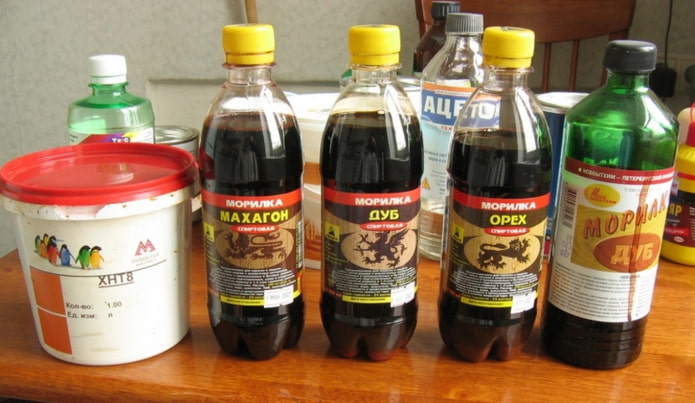
Acrylic and wax stains
The effect of acrylic and wax stains is similar to the effect of oil solutions, but the basis is various types of resins and wax, which envelop the wood, making it moisture-resistant, giving a noble shade and emphasizing the natural relief of the wood.
The consistency of wax and acrylic stains is thick and viscous, more like varnish, the layer is dense and strong, but if the stain is applied unevenly, stains may appear on the surface, so the work requires some skill. Given the high cost, acrylic and wax compositions are most often used to restore furniture and architectural items.
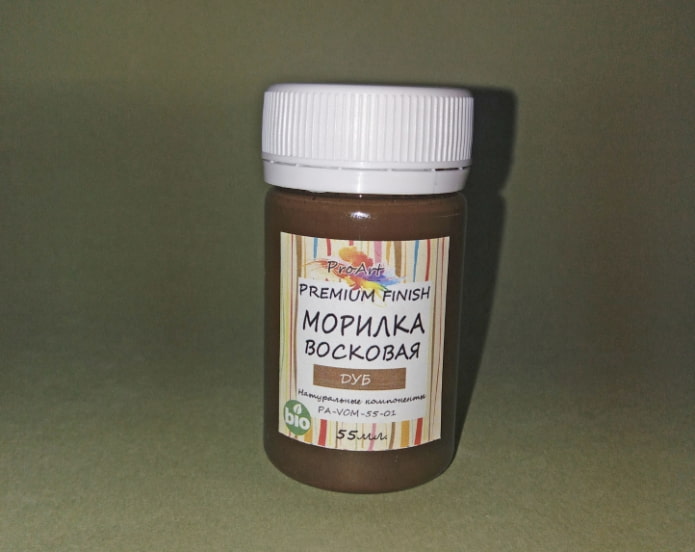
Nitro stains
Stains based on solvents are called nitro stains, in terms of the principle of action, such compositions are similar to stains on an alcohol basis, they dry quite quickly, so it is necessary to work with them as quickly as possible, using sprayers and personal protective equipment.
When working in closed spaces, regular ventilation is required. Nitro stains are ideal for treating small areas.
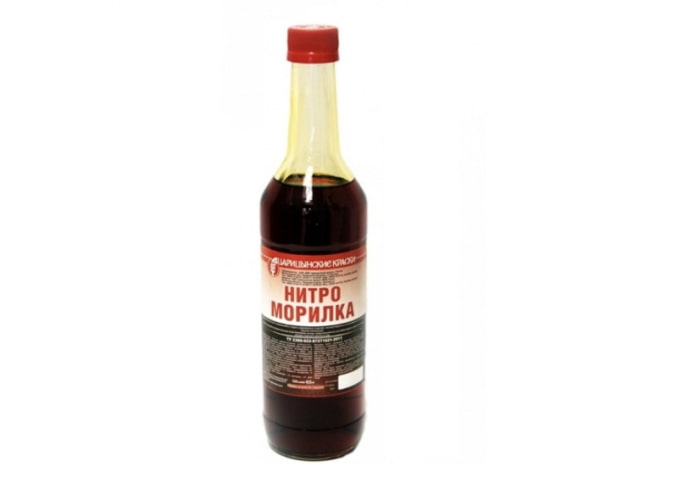
Color palette
Today, stores offer stains in a wide range of colors, from classic brown and dark brown shades to bright exotic shades. When looking through the color palette, you should focus not only on the shade declared by the manufacturer, but also on the natural color of the wood, the same stain applied to different types of wood can give a completely different result.
It is also worth considering that one color from different manufacturers can differ in intensity, so for large volumes of work it is worth purchasing dyes with a small reserve.
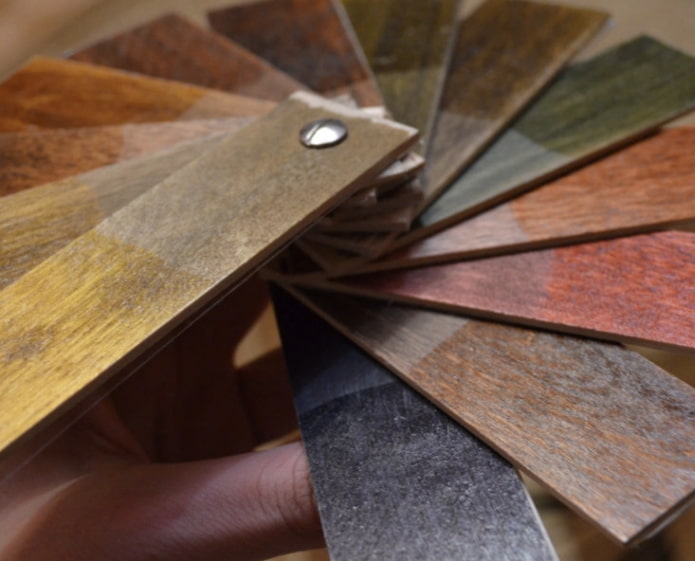
Conventionally, the color palette of stains is divided into three types:
- neutral include black, white and gray tones;
- natural shades include natural natural tones, for example, maple, cherry, walnut, larch, bleached oak, oak, wenge, pine, mahogany, mahogany, mocha, etc.;
- exotic shades give the wood an unusual color, blue, purple, green, yellow, etc.
If the color of the wood is satisfactory, but you want to emphasize the natural pattern, manufacturers offer colorless stains without tinting properties.
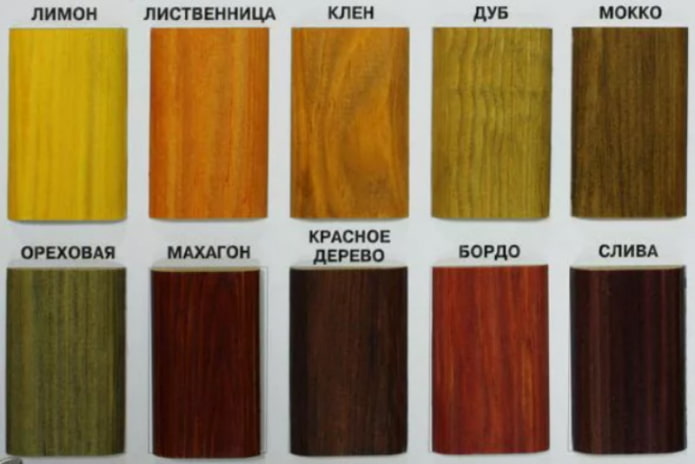
What effects can be created?
For modern design, colored wood painted in unusual colors is increasingly used; a combination of contrasting colors in the decoration of one room looks interesting. Depending on the wishes of the customer or the master, modern stains can be used to create effects for interiors of various styles.
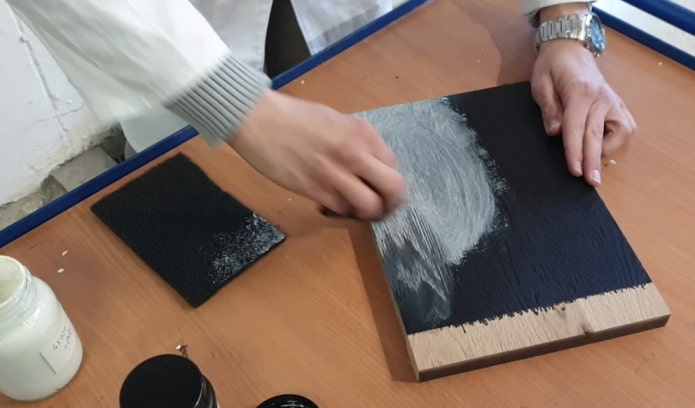
White wooden products with an interesting natural texture will decorate any interior. Exquisite products can be obtained using white wood stain. Bleaching is also used to renew old interior items that have become stained or unsightly over time.
Oak and birch respond best to bleaching, chestnut responds worst to bleaching.

Aging can turn any wooden item into a family heirloom. To achieve natural aging and create a patina effect, a light-colored stain is applied to the surface, and the freshly painted surface is carefully wiped with a soft cloth or brush. Some craftsmen wait until the product dries completely and sand it.
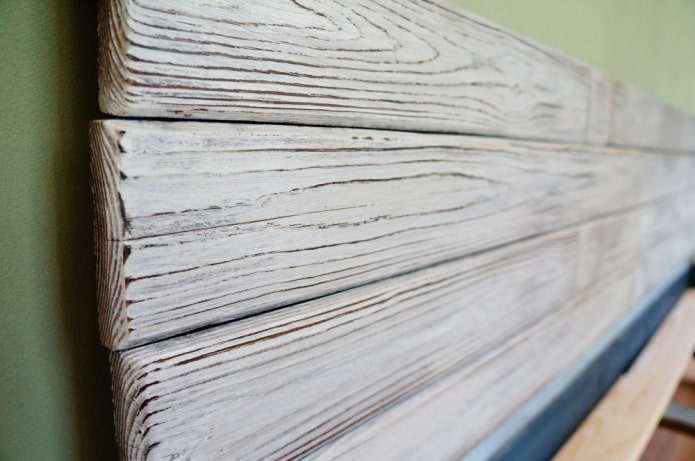
Black ebony with a mirror effect, on which knots and rings are clearly visible, looks expensive and luxurious. To give the material the visual effect of a valuable species, you will need black wood stains marked “ebony” and the hardest types of wood, the surface is first brought to perfect smoothness.
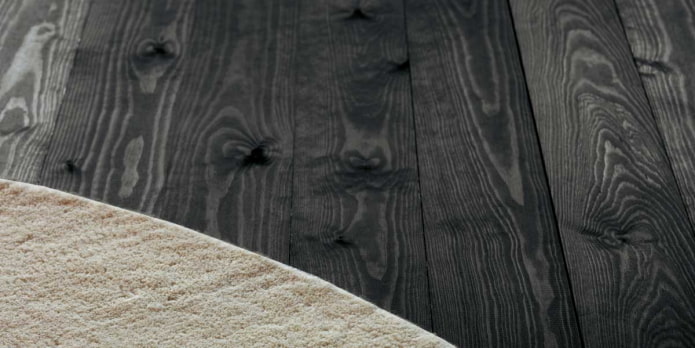
Popular manufacturers
Now let’s look at the most popular compositions that have the best ratings on marketplaces and among consumer reviews.
Novbytkhim water stain. Environmentally friendly composition. It has a large number of colors and perfectly protects wood from moisture. Many users note that the stain has good resistance to abrasion and does not fade. Also, many people write that it holds the color well and does not smell strongly.
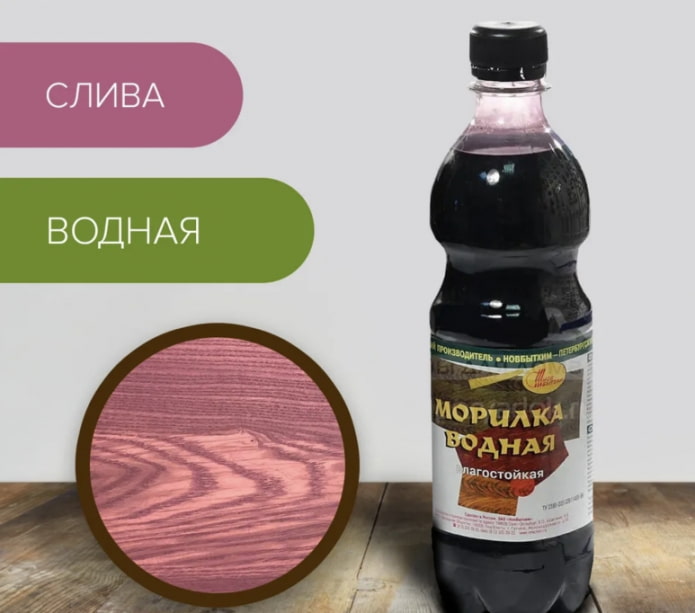
Professional water stain SAFORA. It has a beautiful color that matches the description. If you get a different color than you expected with the first layer, do not be upset. Wait until the composition dries completely. Many people note that it dries quickly and has virtually no odor.
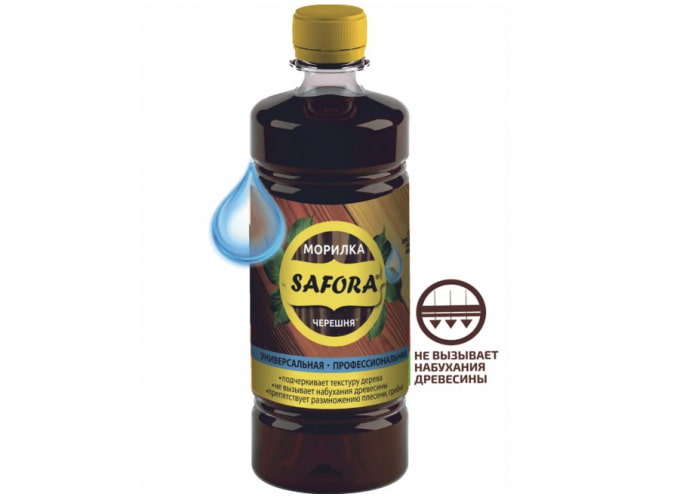
A water-based composition from Zerwood. The range includes a large number of colors of noble tree species. The only thing is that it is recommended to use only indoors. Among the features, it can be noted that it has virtually no odor, dries quickly and has low consumption.
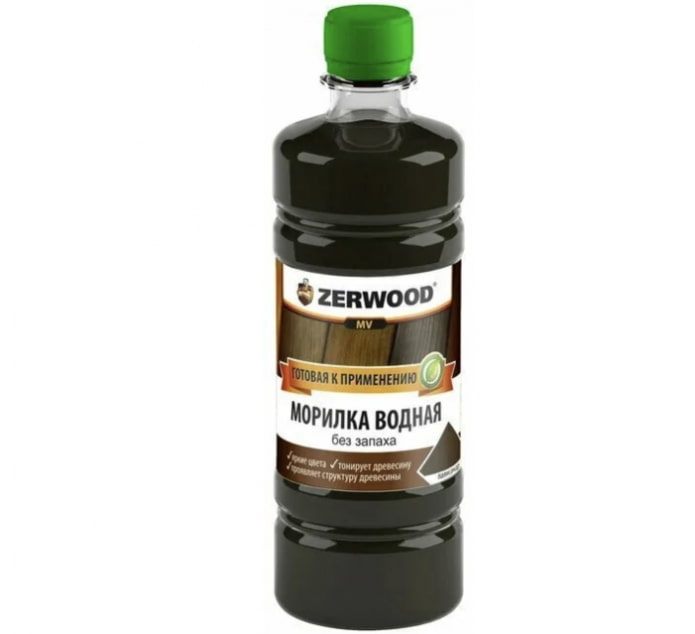
Wood stain Profilux. Another example of an inexpensive but high-quality composition. Perfect for any work and different types of wood. Dries quickly, but the smell takes much longer to disappear. Among the disadvantages, many write that some colors may differ (for example, oak is green, and rosewood gives off a red flavor).
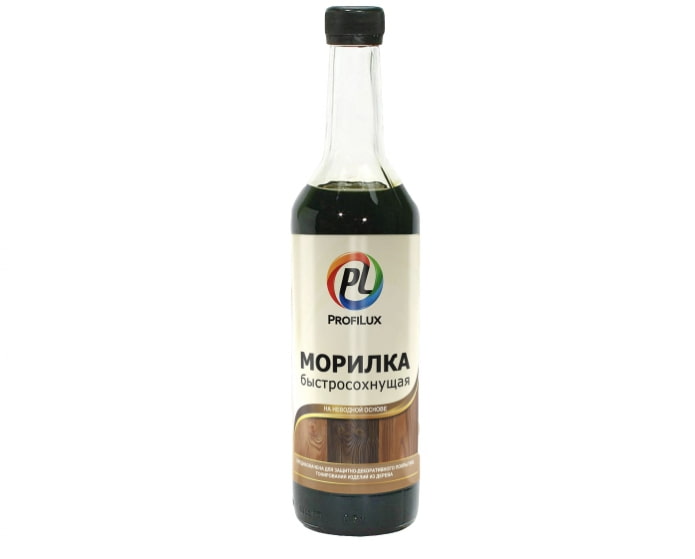
Wood stain from the manufacturer Liberon. It has a high-quality and rich color. There is practically no smell. Also, many users wrote that it dries quickly and does not leave streaks. A special advantage can be considered a convenient container for storage. But for many, the price may seem too high.
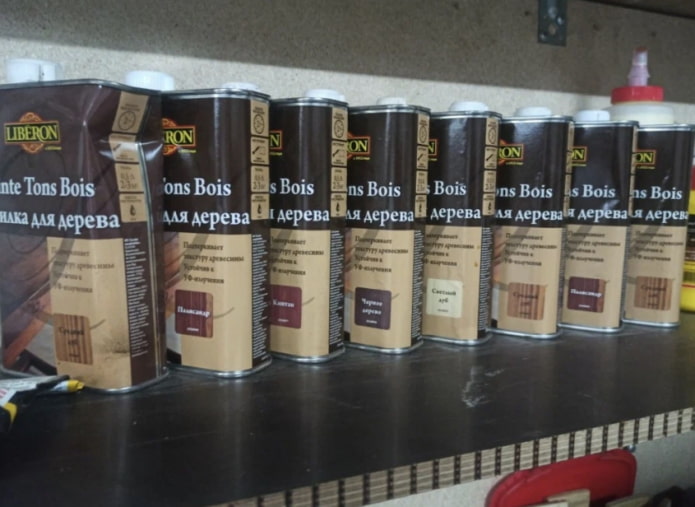
Application methods
The wood stain can be applied in various ways, taking into account the composition, characteristics of the wood and personal preferences. Coniferous trees must first be de-resined, otherwise the resin will not allow the active substances to penetrate inside and the surface will be spotty and unsightly.
Before using water-based stain, the product is doused with warm water a day before staining and dried, this helps to open the pores of the wood and better penetration of the stain, if the surface is rough, it must be sanded to perfect smoothness before water-based stain. Sometimes the packaging indicates the recommended application method, it is better to listen to the manufacturer, then the result is more likely to please the master and the customer. Below we will consider the main application methods.
When rubbing, the dye applied to the wood is evenly distributed over the surface with a sponge or other soft lint-free material. When choosing this method, it is better not to use quick-drying compounds, since rubbing requires careful processing.
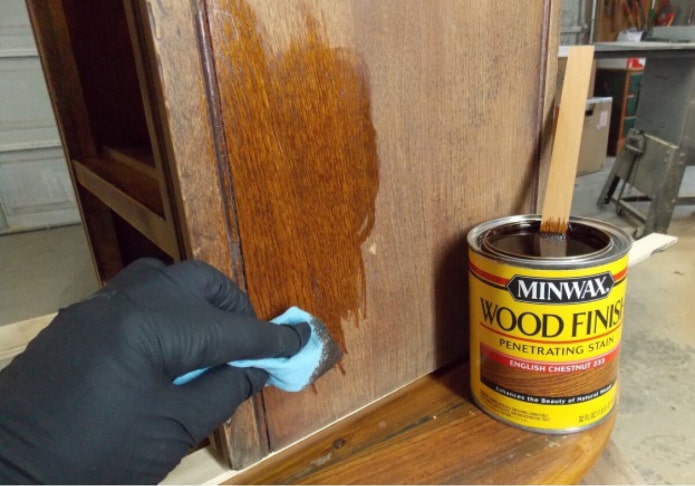
Spraying is done using a special tool – a spray gun. Spraying creates an even and thin coating, to obtain the desired shade, it is often necessary to apply several layers.
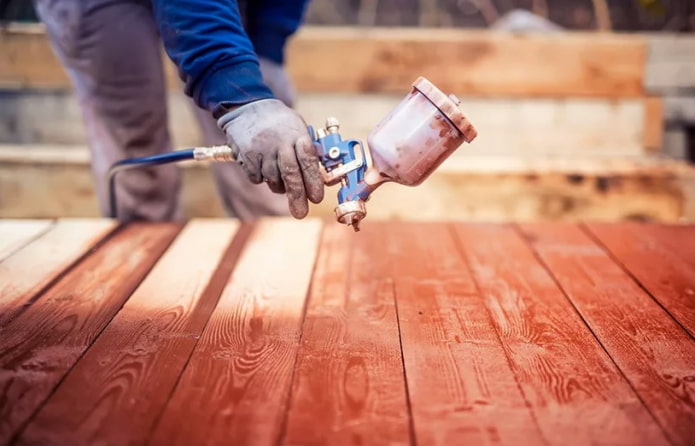
When pouring, a large amount of stain is applied to the surface with a brush and left for 15 minutes to absorb. Then the excess is removed with a clean, lint-free cloth.
Painting with a brush is convenient when processing small and carved surfaces, this method allows you to evenly apply the dye even in hard-to-reach areas, the layer is smooth, which contributes to uniform painting.
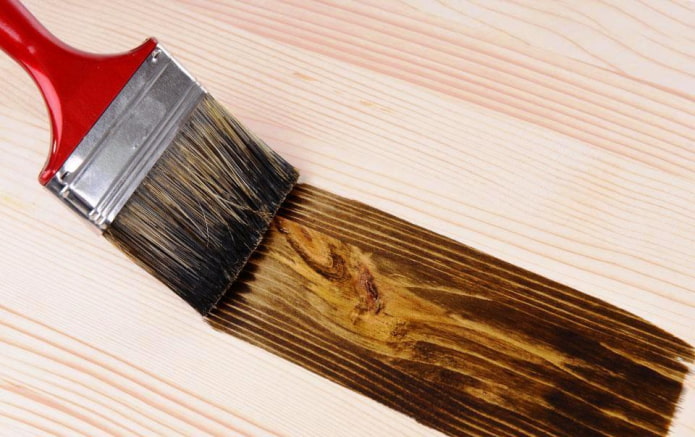
Also see the simple instructions for beginners:
Regardless of the chosen method of application, all stains are applied to the surface of the wood strictly in the direction of the grain.
Now reading:
- effective methods for repairing a hole in a stretch ceiling.
- Discover the Uniqueness of the Fiat Multipla
- Textile wallpaper for walls: more than 70 photos and design ideas for fabric coverings.
- Beautiful ways to make your bed in the bedroom: 50+ photos of stylish ideas with pillows.
- Door Opening Direction: 3 Different Opinions on the Issue